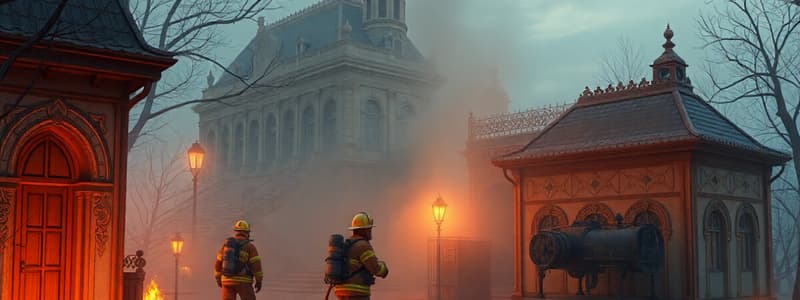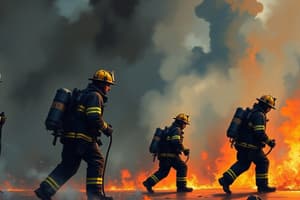Podcast
Questions and Answers
What is the primary purpose of a backup line during a fire incident?
What is the primary purpose of a backup line during a fire incident?
- To monitor fire dynamics
- To supply additional water to the initial line
- To protect the egress of operating crews (correct)
- To assist in extinguishing the fire
How should a backup line be compared to the initial line it protects?
How should a backup line be compared to the initial line it protects?
- It should be shorter in length and have a lower flow rate.
- It should be the same length but have a higher flow rate.
- It should be at least one length longer and have the same or greater flow. (correct)
- It should be half the length of the initial line for efficiency.
What distinguishes a second line from a backup line?
What distinguishes a second line from a backup line?
- A second line has no flow requirement, while a backup line must match the initial line.
- A second line is used for protection, while a backup line is for suppression.
- A second line is needed for egress, while a backup line assists with fire control.
- A second line is used to suppress the fire, while a backup line protects egress. (correct)
When should the terms 'backup line' and 'second line' be used?
When should the terms 'backup line' and 'second line' be used?
Which statement best describes the communication required on the fireground regarding hose lines?
Which statement best describes the communication required on the fireground regarding hose lines?
Why should a backup line be longer than the initial line?
Why should a backup line be longer than the initial line?
What should the flow rate of a backup line be compared to the initial line?
What should the flow rate of a backup line be compared to the initial line?
In which scenario is a backup line essential?
In which scenario is a backup line essential?
Which of the following statements about a second line is true?
Which of the following statements about a second line is true?
How often should a backup line be stretched during fire operations?
How often should a backup line be stretched during fire operations?
Flashcards
What is a backup line?
What is a backup line?
A hose line used to protect the exit route of firefighters operating inside a structure. It should be longer and have the same or higher flow rate than the initial line, in case the primary line is too short to reach the fire or lacks sufficient water flow.
How long should a backup line be compared to the initial fire line?
How long should a backup line be compared to the initial fire line?
A backup line should be stretched at least one length longer than the line it is protecting.
How should the flow rate of a backup line compare to the primary line?
How should the flow rate of a backup line compare to the primary line?
A backup line should have the same or greater flow rate as the initial line.
What is a second line?
What is a second line?
Signup and view all the flashcards
Are the terms 'backup line' and 'second line' interchangeable?
Are the terms 'backup line' and 'second line' interchangeable?
Signup and view all the flashcards
What is the importance of clear communication when requesting hose lines?
What is the importance of clear communication when requesting hose lines?
Signup and view all the flashcards
What is the primary purpose of a backup line?
What is the primary purpose of a backup line?
Signup and view all the flashcards
What is the primary purpose of a second line?
What is the primary purpose of a second line?
Signup and view all the flashcards
Why is clear communication important on the fireground?
Why is clear communication important on the fireground?
Signup and view all the flashcards
Why should the backup line extend beyond the initial line?
Why should the backup line extend beyond the initial line?
Signup and view all the flashcards
Study Notes
Firefighting Knowledge and Skills - Fireground Operations - Backup Line vs. Second Line
-
Introduction: Multiple hose lines might be needed to control a fire. Clear communication is crucial for backup and second lines.
-
Backup Line: A backup line is stretched at every fire. Its purpose is to protect escaping crews. It should be at least one length longer than the primary line, and have the same or greater flow rate. This extra length lets it reach the fire if the initial line can't. It's used to prevent fire growth.
-
Second Line: A second line is used to actively suppress the fire, rather than just protect egress. This line is deployed to directly combat the fire.
-
Summary: "Backup line" and "second line" should be used distinctly. Clear communication helps firefighters know their required actions (suppression or protection).
Studying That Suits You
Use AI to generate personalized quizzes and flashcards to suit your learning preferences.



